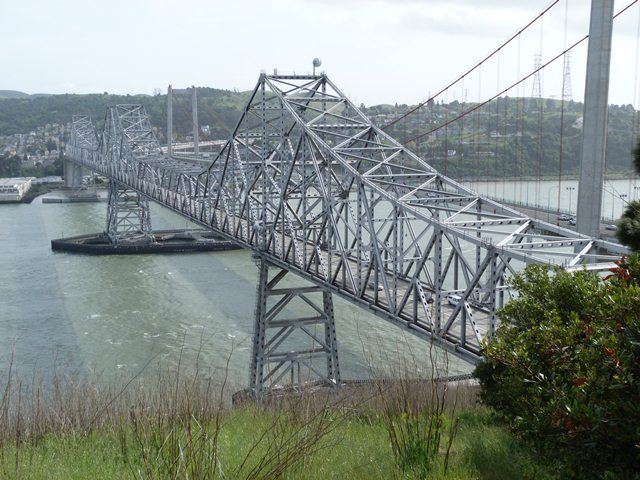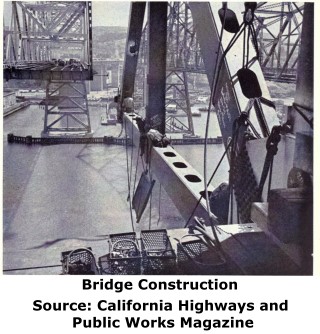We Recommend:
Bach Steel - Experts at historic truss bridge restoration.
Carquinez Bridge
Eastbound I-80 Bridge

Primary Photographer(s): Nathan Holth
Bridge Documented: April 7, 2013
I-80 (Eastbound) Over Carquinez Strait and Railroad (Union Pacific)
Crockett and Vallejo: Contra Costa County, California and Solano County, California: United States
Metal Bolt-Connected Baltimore Through Truss, Fixed and Approach Spans: Metal Stringer (Multi-Beam), Fixed
1958 By Builder/Contractor: American Bridge Company of New York, New York
Not Available or Not Applicable
1,100.0 Feet (335.3 Meters)
5,209.0 Feet (1587.7 Meters)
51.8 Feet (15.79 Meters)
5 Main Span(s) and 28 Approach Span(s)
23 0015R

View Information About HSR Ratings
Bridge Documentation
View Archived National Bridge Inventory Report - Has Additional Details and Evaluation
View Historic American Engineering Record (HAER) Documentation For This Bridge
HAER Data Pages, PDF - HAER Original Plan Sheets, PDF
View Historical Articles About This And The Previous Cantilever Bridge

Please note that the HAER documentation refers to a previous bridge that once stood next to this bridge. It has been included because the history of that bridge is key to understanding this bridge. In 1927, a cantilever bridge was completed at this location. Decades later, a need for more traffic lanes was needed and therefore a second cantilever truss bridge, the one that is extant today, was completed in 1958, allowing the 1927 cantilever to carry westbound traffic only while the new bridge carried eastbound traffic. This bridge assumed the same overall cantilever truss design as the 1927 bridge, and its trusses were also designed with the same arrangements and configurations. However, the composition of the beams that made up the trusses of the new bridge were completely different in design, foregoing rivets, v-lacing and lattice for welds, rolled beams, and built-up beams with welded plate with punched holes. As a result, the 1958 bridge looks very much like the 1927 bridge when viewed from elevation at long distances, but up close it looks very different. In 2003, the highly significant historic 1927 bridge was replaced by a new suspension bridge. This solution was chosen to address seismic issues rather than simply preserving the historic bridge through a seismic retrofit. It should be noted that this replacement bridge was built on a slightly different alignment so that the historic 1927 bridge remained in place after its completion. As such, the 1927 bridge was able to carry traffic while the 1958 bridge received a seismic retrofit. In 2007, despite the fact that the historic bridge was not in the way of its replacement bridge, and despite its high level of historic significance, this bridge was demolished.
In the wake of the demolition of the 1927 bridge, the 1958 bridge, while nowhere near as significant, does have some historic significance. It still conveys the truss configuration of the 1927 bridge. It also is a relatively early example of a long-span type bridge that used welded built-up beams as opposed to riveted built-up beams. With its truss configuration the same as the 1927 bridge, but with these welded built-up beams (and connected by bolted connections rather than rivets) the 1958 bridge made a unique comparison to the 1927 bridge since it was a way to see how essentially the same bridge design was built in different decades, and thus it nicely illustrated how fabrication and truss fastener technologies had evolved. Today, the bridge is an increasingly rare example of a cantilever truss bridge, and so its historic significance grows as a result.
While today, bridge historians have gained an appreciation for the beauty and craftsmanship in earlier riveted truss bridges, it is interesting to note that when the 1958 bridge was built its use of bolted connected and its lack of v-lacing and lattice were described in news articles as both better in terms of design, but were also described as more aesthetically pleasing with their simple, streamlined appearance in comparison to the 1927 bridge. It is odd how times change, since in today's world where bridges suffer visually from excessive simplicity and plainness, it is hard to imagine that the 1927 bridge with its v-lacing and lattice forming a unique geometric art as anything but beautiful.
Above: Historical advertisement featuring bridge.
![]()
Photo Galleries and Videos: Carquinez Bridge
Bridge Photo-Documentation
Original / Full Size PhotosA collection of overview and detail photos. This gallery offers photos in the highest available resolution and file size in a touch-friendly popup viewer.
Alternatively, Browse Without Using Viewer
![]()
Bridge Photo-Documentation
Mobile Optimized PhotosA collection of overview and detail photos. This gallery features data-friendly, fast-loading photos in a touch-friendly popup viewer.
Alternatively, Browse Without Using Viewer
![]()
Maps and Links: Carquinez Bridge
Coordinates (Latitude, Longitude):
Search For Additional Bridge Listings:
Bridgehunter.com: View listed bridges within 0.5 miles (0.8 kilometers) of this bridge.
Bridgehunter.com: View listed bridges within 10 miles (16 kilometers) of this bridge.
Additional Maps:
Google Streetview (If Available)
GeoHack (Additional Links and Coordinates)
Apple Maps (Via DuckDuckGo Search)
Apple Maps (Apple devices only)
Android: Open Location In Your Map or GPS App
Flickr Gallery (Find Nearby Photos)
Wikimedia Commons (Find Nearby Photos)
Directions Via Sygic For Android
Directions Via Sygic For iOS and Android Dolphin Browser
USGS National Map (United States Only)
Historical USGS Topo Maps (United States Only)
Historic Aerials (United States Only)
CalTopo Maps (United States Only)






